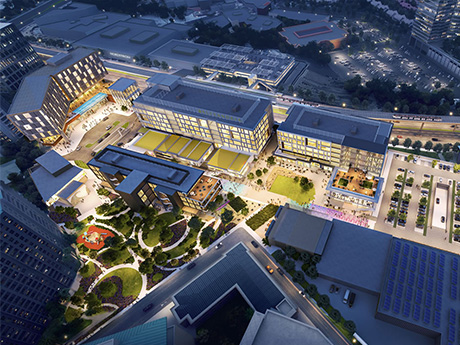By John Hickman, Managing Director, NewMark Merrill
San Diego may be California’s second most populous county, but you wouldn’t know it by strolling through one of its many business districts. The county has grown up since its early days as a small military outpost, yet today its hundreds of communities and neighborhoods still impart a small-town feel.
The retail real estate market reflects an intimate beach town vibe with a tightly knit brokerage and landlord community. Brokers and investors can cover the market with a limited footprint, while many retailers can achieve a major presence with a handful of locations. This is opposed to the dozens of locations they may require in other California markets, such as Los Angeles, Orange County and the Bay Area. And big, national brands aren’t the only retailers finding success — 98 percent of firms in San Diego are small businesses.
Retailers in San Diego are open to taking chances on new concepts and structuring different types of leases. They’re also willing to pay slightly higher rent to gain access to the area’s strong demographics and limited supply of new shopping centers. This uniqueness provided resiliency during the pandemic and will contribute to a thriving market for the foreseeable future.
For example, foot traffic has fared well in its bounce back from COVID, according to Placer.ai. The firm reports that across all San Diego County retail categories, foot traffic is currently at 95 percent of what it was in March 2019, but that only tells part of the story. Certain categories have done exceptionally well, with fitness foot traffic leading the way at 112 percent, followed by spa and beauty and medical and health all at 99 percent. Other categories have bounced back well and are close to pre-pandemic levels, with grocery at 97 percent, dining at 93 percent and apparel at 92 percent.
San Diego Retail Pre-Pandemic
The San Diego retail market saw very little new development in 2019, save for a handful of large malls.
This included Horton Plaza, which is undergoing substantial redevelopment to include mixed-use. Meanwhile, occupancy reached a high of 95 percent across all retail types, while lease rates had accelerated for several years, creating a very strong market overall.
It was also a constrained investment market with abundant capital chasing very few available properties. This caused cap rates to compress to a low of 5 percent. Landlords were continuing to invest in centers with improved common area amenities and new technology to better understand consumers.
Additionally, 2019 was a time when many types of retail users were seeking available space, from restaurants and entertainment companies to medical offices and small shops. At the time, big box retailers like Target, Home Depot, Walmart, Lowes and others were starting to grow their smaller-concept locations in San Diego County’s infill areas. Mid-sized retailers occupying 20,000 to 40,000 square feet, such as Ross and HomeGoods, were also finding stiff competition from grocers and gyms for available space.
Food and beverage companies were expanding, especially fast-casual restaurants like Urbane Café and California Fish Grill. Many restaurants were looking to add drive-thrus to their already successful concepts, such as Panera, Chipotle and the Habit Burger Grill.

Horton Plaza, an outdoor shopping mall in downtown San Diego, is being redeveloped into Horton Campus, an innovation hub that will include creative office, entertainment, retail and restaurants components
Weathering the Pandemic Storm
Fast forward to 2020. As the pandemic wore on, most retail tenants were able to weather the two-year storm with the help of the Paycheck Protection Program (PPP) and landlord support.
Shopping centers filled a void, becoming a place for connection and gathering thanks to the many master-planned communities and landlords that provided community programming.
As in many regions, restaurants and grocers in San Diego increased their sales. Restaurants that adapted for outdoor seating and drive-thru concepts experienced success that will continue into the future. Retail landlords also saw increased interest from “medtail” — healthcare services offered in retail settings — with the growth of urgent care centers and other similar medical concepts in multiple submarkets.
The pandemic gave investors time to envision new outcomes for dated shopping centers and malls. Developers broke ground on new redevelopment projects like Costa Verde near UTC and the aforementioned Horton Plaza, which will both be turned into new mixed-use communities.
Looking Ahead: Opportunities for Growth
San Diego retail will continue to benefit from its geography, climate, low vacancy, lack of developable land and high barriers to entry. The region will also see sustained acceleration of several pandemic trends. For now, cap rates continue to face downward pressure with several notable centers now trading well below the 5 percent cap threshold seen pre-pandemic.
Home improvement and furniture retailers will flourish as people continue renovating and redesigning their houses into hospitality-like sanctuaries, especially with many people continuing to work from home at least some of the time. Small-format fitness operators that emerged during the pandemic will also continue expanding this year and beyond.
In the food and beverage sector, the evolution of drive-thru concepts continues, with restaurants like Dutch Bros. Coffee, Chipotle and others opening drive-thru-only locations with no seating available. Another food brand expanding along the West Coast is Bay Area-based Amy’s Drive Thru. They are the nation’s first organic, vegetarian drive-thru, serving American classics with a conscience. Several new concepts have opened in San Diego County in the first quarter of 2022, with more planned or in development.
On a broader scale, the explosion of San Diego’s life sciences industry has allowed the market to attract higher-waged professionals and achieve overall population growth. That positive trend, combined with the recovery of the tourism industry, bodes well for a strong resurgence of retail in the coming years. The retail real estate community can expect to see increased demand for retail, restaurants and services for years to come.



